GUEST EDITORIAL
Whether in a truck, camera car, office or on the lot, asset recovery professionals, when it comes to having gear on their person often have tools to take a life. Not too many people think about carrying items that might sustain their life or the lives of others.
Just because we have SACAT training that can answer the predicament of violence doesn’t mean we should not also have the basic lifesaving skills and equipment to keep ourselves or someone alive until medical professionals arrive.
In this short message I will go over the most common prevention methods to keep a victim from dying, what minimalist medical equipment (MME) you should have on your person or in your vehicle and the four basic lifesaving items you should carry.
WHY BASIC MEDICAL CARE IS VITAL
Many variables exist during a violent encounter, accidental or intentional, and its aftermath. An impact from a blunt object, the puncture of a blade, or a penetrating bullet wound may all cause instant death. These may be due to an instant lack of functioning of the Central Nervous System (CNS) in the brain, commonly found in victims with a headshot wound.
Other instantly fatal injuries can include puncture or penetration of the heart or major arteries (femoral, brachial, carotid, and radial). Even if these wounds are apparent, you should still attempt to render aid to the victim, especially if they are conscious, breathing or have a pulse. Only a small percentage of people survive a gunshot wound (GSW) to the head, but it is possible, as we have seen.
The human body is extremely resilient, and simple measures can give the victim a chance of survival. Applying direct pressure at the point of injury may sustain life until medical professionals arrive.
As I have witnessed through the years, one of the biggest killers of victims of gunshot wounds or knife punctures is blood loss. It has been my experience many survivors of the initial wound bled out due to lack of formal training and lack of tourniquets. Many lives may be saved if basic pressure to the wound can be applied.
Tourniquet Application
Major source of expiration of the victim of a gunshot wound is blood loss. Knowing how to apply direct pressure to the wound or how to apply a tourniquet is vital. Today a multitude of items can be utilized for a victim when applying pressure and preventing blood loss are paramount.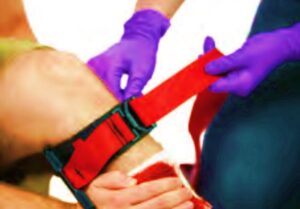
The first is a pressure dressing, which comes in a variety of “flavors” from different manufacturers and is designed to do two things: wrap the wound and keep pressure on it. In the field, where you may not have access to a pressure dressing, using a bandana or even the victim’s own clothing can work. Basically, anything you can put over the wound and apply pressure with will do the job.
The first item is the infamous tourniquet, which also comes in a variety of brands and models. It was originally considered a “last option” tool if blood loss to an extremity could not be stopped by direct pressure.
The thought process was that the limb the tourniquet was used on would most likely have to be amputated because the tourniquet created so much pressure and cut off blood flow. But military doctors saw that many troops who had tourniquets applied in the field did not lose their limbs, even after having the tourniquet in place for over two hours.
Therefore, while working government contracts, operators were required to have a tourniquet in their Individual First Aid Kit (IFAK). In a pinch, anything that can cinch down above the wound will work, such as the belt off your pants or the strapping used to tie down equipment in a pick-up truck.
The second item and most recent tool for the cessation of blood loss is the hemostatic agent. As stated here, the first attempt to make a form of dry fibrin hemostatic product for use by trauma surgeons was during World War I, when Grey and Harvey produced pre-polymerized fibrin tampons and thin plaques to control bleeding in parenchymal organs.
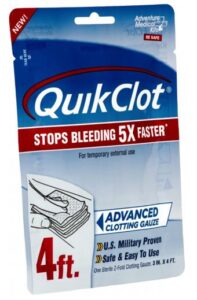 The two most recent products that most people can buy are QuikClot and Celox. The latter is new to the medical scene and in my opinion is much more patient friendly. Unlike QuikClot, which heats to an extremely high temperature when it comes in contact with liquid and somewhat cauterizes the wound, Celox does not.
The two most recent products that most people can buy are QuikClot and Celox. The latter is new to the medical scene and in my opinion is much more patient friendly. Unlike QuikClot, which heats to an extremely high temperature when it comes in contact with liquid and somewhat cauterizes the wound, Celox does not.
Celox is made using chitosan, a natural polymer extracted from the shells of shrimps and crabs. When used on an open wound, the Celox granules swell up and turn into a gelatin-like substance. There is no heat present when this process occurs. There have been great results with the use of Celox, but QuikClot still reigns over government contracts.
Whichever product you purchase, know how to use it properly and that it’s a last resort if bleeding cannot be stopped by either direct pressure or a tourniquet.
The third item is a Chest Wound Seal which may be purchased commercially under the names of HALO Seal, Rhino Rescue Seal, and ER Chest Seal and is utilized for “sucking chest wounds.
In an emergency you may use Saran Wrap, Ziploc Bag, Credit Card, and Duct Tape. When applying over the wound a critical element is to tape only three edges down allowing air to escape the body cavity.
The fourth and final item is NARCAN (naloxone HCL) which is used to treat Opioid overdose. Agents may come into contact with Fentanyl when inventorying vehicles and the drug may be absorbed through the skin causing instant unconsciousness.
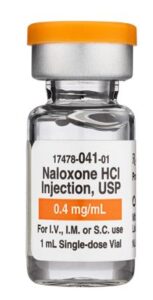 Knowing how and when to properly administer NARCAN is vitally important. NARCAN may be obtained at your pharmacy without a prescription or with a prescription at a lower cost. I have obtained it from the Oklahoma State Drug Prevention Unit at no cost for distribution to my employees.
Knowing how and when to properly administer NARCAN is vitally important. NARCAN may be obtained at your pharmacy without a prescription or with a prescription at a lower cost. I have obtained it from the Oklahoma State Drug Prevention Unit at no cost for distribution to my employees.
WRAPPING UP
If you take personal defense seriously as an asset recovery professional, knowing basic casualty care and how to use MME are essential. In our profession you or someone near you may be injured or wounded at any time.
Knowing how to apply basic pressure as well as other skills may mean the difference between life and death. A cautionary example is that if someone gets cut only a quarter of an inch below the skin along the radial artery (which lies near your wrist), they will lose consciousness in 30 seconds, and death will occur in two minutes if left untreated.
You may be the only one on scene during the aftermath of a violent attack — do you have the skills to preserve life?
Join me at the Allied Finance Adjusters Mid-Year Conference in Las Vegas next month and attend the session, “2022 A YEAR OF VIOLENCE…Recognizing, Avoiding, and Responding to Acts of Violence Against the Asset Recovery Profession”.
Remember “The life you save may be your own…”




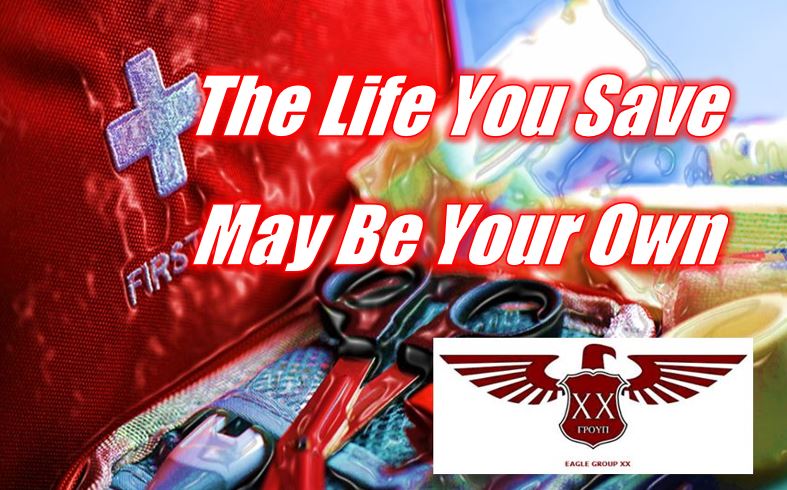
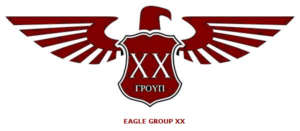










Facebook Comments